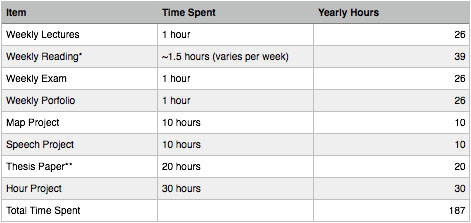WHAT YOU NEED TO GET STARTED
Lesson Videos
- Available on DVD, as digital downloads, and streamed as an individual subscription or as part of the Compass Classroom Membership
- 26 lessons with 5 videos each; additional videos explain the quarterly projects
Student Reader
- Available as digital files with your purchase, or as a separate download or printed book (225 pages)
- Includes daily readings, assignments, and weekly exams.
Portfolio
- Essentially a scrapbook or a visual textbook for the semester’s lessons which shows the lessons that have been verbally discussed.
- Provided by the student: a scrapbook, photo album, 3-ring binder, or a fine sketchbook of durable quality such as card stock or a heavy drawing paper.
Teacher’s Guide
- Scope & Sequence for two semesters of Middle/High School (Ages 13+)
- Portfolio & Project Guide
- Grading Guides for Exams, Readings, the Portfolio, and Projects
- Suggested Literature to go along with Lessons
- Exam Answer Key
Need help organizing the digital curriculum? We’ve got a helpful entry on our blog that covers just that!
HOW DAVE RAYMOND’S ANTIQUITY WORKS
There are a number of different elements to this curriculum that make it quite unique.
Once you see how everything works together, however, it should be fairly easy to teach. You will also want to watch all five parts of Lesson 1 – Orientation. The entire curriculum is explained in detail there.
The class is designed to fill two semesters. It covers 26 Lessons with the goal of completing one Lesson per week. Each Lesson is broken down into five different lectures (approximately 15-20 minutes each) with associated readings or assignments.
Each day, plan on scheduling approx. 20 minutes for the video and 15 minutes for the daily reading and questions.
Each week, budget approximately 20 minutes for the exam, and another 20 for the Lesson’s Portfolio entry. These elements can be modified to suit the age and frame of your student. For example, parents of middle school students might remove the daily readings to concentrate on the Portfolio, and integrate the Exam questions as a summary of the applicable lesson video.
You can assign one lecture a day or you can go through two or more lectures in one day. Your student will be the best gauge as to how much he or she can effectively cover at one time.
The readings in the second semester of this series are often longer than the readings in the first half. As the teacher, feel free to abridge any of the writings to more appropriately challenge your student.
One Lesson is normally completed per week. Use the included chart (sample) to mark off what has been finished. Only exams, essays and projects are scored.
If an Assignment asks one or more questions, these are meant to be considered by the student as he or she does the reading. You can also use these questions as a way to discuss the lesson with your student after the lesson and readings are complete.
CALCULATING HIGH SCHOOL CREDIT FOR HISTORY

HSLDA recommends spending approximately 150 hours on a subject to qualify for high school credit.
This is how Dave Raymond’s classes generally break down to achieve that credit. Some students will spend more time in some areas and some will spend less, but there is clearly enough different types of work to qualify for full high school credit.
The reader includes over 220 pages of original historical materials. It increases in length as the year progresses. For example, Lessons in the first semester comprise approximately 90 pages while those in the second comprise approximately 130 pages. If additional reading is desired for older students, we include recommendations for that.
If a parent desires to do two or more thesis papers for older students, that is perfectly acceptable and will only increase the amount of time spent in the class.
Suggested Titles for Further Reading
Corresponding roughly to the chronology of the course
- Literary Introductions to the Books of the Bible by Leland Ryken
- Genesis
- Paradise Lost by John Milton
- The Epic of Gilgamesh, translated by N.K. Sandars
- Tales of Ancient Egypt by Roger Lancelyn Greene
- Leviticus & Hebrews
- Ruth
- I & II Samuel
- Proverbs & Ecclesiastes
- On the Incarnation by Athanasius
- The Man Born to Be King by Dorothy Sayers
- The Bhagavad-Gita: The Song of God, translated by Swami Prabhavananda & Christopher Isherwood
- The Everlasting Man by G.K. Chesterton
- The Analects, translated by D.C. Lau
- Classical Gods and Heroes, translated by Rhoda A. Hendricks
- Till We Have Faces by C.S. Lewis
- The Odyssey by Homer, translated by Robert Fagles
- Oedipus Rex by Sophocles, translated by Robert Fagles
- The Portable Greek Reader, ed. W.H. Auden (Selections by Plato & Aristotle)
- Julius Caesar by William Shakespeare (Oxford School Shakespeare Edition)
- The Aeneid, translated by Sarah Ruden
